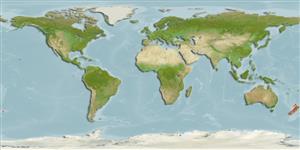Common names from other countries
>
Eupercaria/misc (Various families in series Eupercaria) >
Labridae (Wrasses)
Etymology: Notolabrus: Greek, noton = back + Greek, labros = voracious (Ref. 45335); celidotus: Specific epithet, Greek word 'kelidos' meaning stain or spot, 'otos' meaning ear, referring to the dark markings behind the ears..
More on authors: Bloch & Schneider.
Environment: milieu / climate zone / depth range / distribution range
Ecologia
marinhas; estuarina associadas(os) a recifes; intervalo de profundidade 22 - 145 m (Ref. 58489). Temperate
Southwest Pacific: New Zealand, including Stewart Island, but not recorded from Snares Islands, Clatham Islands, nor the Three Kings Islands.
Tamanho / Peso / Idade
Maturity: Lm ? range ? - ? cm
Max length : 23.9 cm SL macho/indeterminado; (Ref. 26203); idade máx. registrada: 7 anos (Ref. 31614)
Inhabits shallow water, but may reach to depths of 145 m (Ref. 26203). Feeds on small benthic organisms. Uses its forward-jutting front teeth to rake food from the substrate (Ref. 26966).
Ciclo de vida ou comportamento de acasalamento
Maturidade | Reprodução | Desova | Ovos | Fecundidade | Larvas
Pelagic spawner. Also Ref. 27221.
Russell, B.C., 1988. Revision of the labrid fish genus Pseudolabrus and allied genera. Rec. Aust. Mus. (Suppl. 9):1-72. (Ref. 26203)
Status na Lista Vermelha da UICN (Ref. 130435)
CITES (Ref. 128078)
Not Evaluated
Ameaça para os humanos
Harmless
Uso pelos humanos
Mais informação
ReferênciasAquaculturaPerfil para aquaculturaEstirpesGenéticaElectrophoresesHereditariedadeDoençasProcessamentoConversão de massa
ColaboradoresFotosStamps, Coins Misc.SonsCiguateraVelocidadeTipo de nataçãoÁrea branquialOtólitosCérebrosVisão
Ferramentas
Relatórios especiais
Baixar XML
Fontes da internet
Estimates based on models
Preferred temperature (Ref.
115969): 10 - 18, mean 14.3 (based on 49 cells).
Índice de diversidade filogenética (Ref.
82804): PD
50 = 0.5078 [Uniqueness, from 0.5 = low to 2.0 = high].
Bayesian length-weight: a=0.00794 (0.00466 - 0.01353), b=3.07 (2.93 - 3.21), in cm Total Length, based on LWR estimates for this species & (Sub)family-body (Ref.
93245).
Nível Trófico (Ref.
69278): 3.4 ±0.3 se; based on diet studies.
Resiliência (Ref.
120179): médio(a), tempo mínimo de duplicação da população 1,4 - 4,4 anos (tmax=7; k >0.30).
Fishing Vulnerability (Ref.
59153): Low vulnerability (19 of 100).
